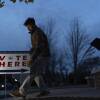There were warnings well before a vaccine for COVID-19 was a reality — worries about whether traditionally underserved communities would get a fair share of the precious medicine and weary resignation that the greedy, the rich and the scammers would figure out a way to get to the front of the line.
For the most part, they were right. Some people who’ve found ready access to vaccine inoculation sites — and others with just the right connections — have been able to game the system. Like the board members of the Rhode Island-based hospital groups Lifespan and Care New England, who were offered vaccines while some seniors with first priority were still waiting. The groups claimed to have broad eligibility for all of the staffers that went beyond their frontline healthcare workers. Board members as essential? I don’t think so.
Meanwhile, many of the real essential workers live in the most vulnerable communities, where the impact of social determinants like poverty, crowded housing, food insecurity and air quality contribute to poor health outcomes — neighborhoods where, to date, they are both most at risk for infection and the least likely to have been vaccinated. These are the bus drivers, the janitors, the supermarket clerks, the grocery store delivery workers and the myriad of others who keep the daily systems we rely on running. Because they can’t do their jobs from home, they have been constantly exposed.
These overwhelmingly Black or Latino workers living in hard hit communities like Chelsea suffer the documented highest rates of virus infection and the lowest rates of vaccine inoculation in the state and across the country. In late January, the Centers for Disease Control and Prevention reported that of all the people to get the vaccine, 60% identified as White, but only 11% as Latino and a little over 5% as Black. In Massachusetts, state data reveals that as of early February only 3% of Black people had been vaccinated. Combined, the numbers of Black, Latino and Asian are only 10% of the those who’ve gotten the shot.
That’s an alarming disparity even if the vaccine rollout in Massachusetts has been, well, a mess in general. Left unchecked, the disparity will get worse. Health experts urge better data collection by race and ethnicity. But most importantly, some have called for targeted, intensive vaccination in Black and Brown communities. Writing in The Washington Post, emergency room physician and head of Advancing Equity Uche Blackstock pointed to “overwhelming data” that even within vaccine priority groups such as health care workers and nursing home residents, “Black Americans have fared worse.”
Locally activists have called on Gov. Charlie Baker to target at-risk groups by expanding access through venues like Roxbury’s Reggie Lewis Center and promoting more on-the-ground outreach in underserved neighborhoods. Where are the culturally specific materials? The trusted voices out front touting safety and efficacy? Not much of that is underway.
It makes sense to prioritize the communities where the death rate and infection rate is highest. Scientists have made it clear that we are now in a race to get more shots in arms before the variant strains of the virus spread. There is no getting to the long hoped-for herd immunity if you ignore or bypass the people in greatest need.
None of us are protected unless they are, too.





